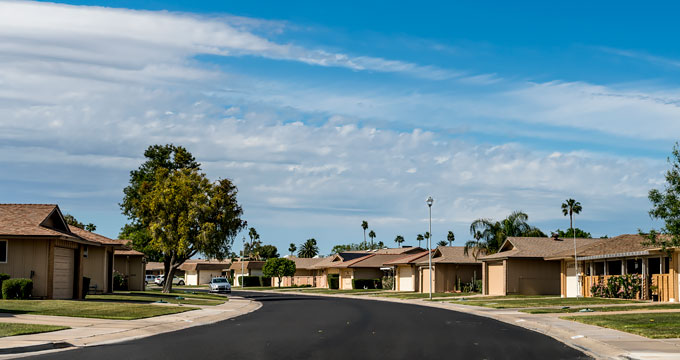
Like most property transactions, the cost of moving into a retirement village can start adding up before you’re even close to getting in the door. Source: Getty
Oct 28 2019
Complete Guides to Retirement Village Costs and Fees
Moving into a retirement village can provide plenty of benefits for those aged 55 or over. From the sense of community, easy access to facilities and low maintenance living, there are plenty of options available to make living easier in your retirement.
However, this new style of living can come with a range of new fees and payments that you may not have encountered before and it can be even more confusing when the fees change depending on the type contract you’ve entered into.
We’ve broken down the costs to make it easier to choose the right retirement village:
Types of Retirement Village Contracts and Tenures
The types of fees you end up paying can depend a lot on the type of contract your retirement village uses.
Here are three of the most common contracts and tenures used by retirement villages in Australia.
Loan or Licence to Occupy
This type of contract is the most widely used for Australian retirement villages. This is where you pay a fee to live in the retirement village but do not own your apartment or unit. The ingoing cost is essentially an interest-free loan to the retirement village in exchange for your right to live there.
Leasehold
If your retirement village uses leasehold contracts, this means the operator owns the residences and you will be signing a long-term lease.
Often these leases will last for 99 years, however, in some cases, they can be shorter. If your lease is for 50 years or more you will be considered a registered interest holder, and if the lease is less than 50 years you will be a non-registered interest holder.
These contracts are often “assignable,” which means you can sell the remainder of the lease to a new resident when you decide to leave.
Freehold Title
A freehold contract for a retirement village is one of the least common types of contracts. If your retirement village uses this type of contract then you will own the apartment, villa or unit, exactly the same as if you were buying a house including paying Stamp Duty on your purchase.

A freehold contract for a retirement village is one of the least common types of contracts. Source: Getty
Before You Move In
Like most property transactions, the cost of moving into a retirement village can start adding up before you’re even close to getting in the door but if you’re prepared, you can budget for these now and avoid bill shock.
Waiting List Fees
Like any sought after product or service, many retirement villages have waiting lists and there is often a cost to join the list. Before paying, you should find out:
- How much the waitlist fee is.
- The average time on the waitlist before being offered a property.
- If there are refunds available if you change your mind or if you are not offered a place after a certain period of time.
Deposits
Most retirement villages will also require a deposit before you move in, similar to paying a deposit for a house. Before paying, you should ask:
- How long is the deposit held for?
- Is there is a ‘cooling-off’ period applicable in your state or territory that will let you change your mind and receive a refund on the deposit?
- If you are able to receive a refund, are there any administration fees applicable on refunds?
“From the sense of community, easy access to facilities and low maintenance living, there are plenty of options available to make living easier in your retirement.”
Moving In
Any move will end up costing money, and moving into a retirement village is no exception. However, you’ll need to be prepared for some fees and costs you may not have come across before.
Entry Costs and Ingoing Contributions
This is where the type of contract you entered into will make a difference. It is also most likely going to be the biggest fee you pay.
If your contract is a loan or licence to occupy your contract may refer to these initial fees as an ingoing contribution, an interest-free loan or a refundable deposit.
These fees are usually up-front costs but most are refunded in part when you leave the village. Some retirement villages will allow you to negotiate a lower ingoing contribution in exchange for the operator retaining a larger amount when you leave.
If your contract is a leasehold then the entry payment will most likely vary under market conditions, like house prices do. For freehold contracts, you will pay a purchase price that gives you the legal title for the property. The cost for freeholds is negotiated with the seller.
Stamp Duty
If your contract is a freehold then you will need to pay Stamp Duty on the property.
If your contract is for a leasehold then you will most likely need to pay Stamp Duty depending on the state you live in and the length of the lease.
If your contract is a loan or licence to occupy, Stamp Duty will most likely not apply to you.
Moving Costs
Don’t forget to factor in the costs of actually moving when budgeting for your move to a retirement village.

Just like any home, retirement villages have bills, fees and charges that need to be paid periodically. Source: Getty
Ongoing Costs
Just like any home, retirement villages have bills, fees and charges that need to be paid periodically. Do the math early so you know how much you can expect to pay.
Maintenance or Management Fees
Almost all retirement villages will charge ongoing maintenance or management fees, usually payable every week, fortnight or month. These fees will cover the cost of:
- Managing the village, including staff and standard services.
- Standard maintenance to take care of common areas and facilities that are available to all residents.
- Utility bills for common areas including electricity, water for garden beds, etc.
As a general rule, the more standard services and facilities provided by the retirement village, the more expensive these fees will be.
“Almost all retirement villages will charge ongoing maintenance or management fees, usually payable every week, fortnight or month.”
While these fees may be set out in your contract, they can increase at any time. This could be due to increase in CPI, as approved by a resolution of the residents ‘ committee or the majority of residents, increase in salaries for the staff, or increase in taxes or charges that relate to the retirement village.
As these are ongoing costs, you should check your contract to see how many of these fees need to be continued to be paid, and for how long if you are no longer able to live at the retirement village and a new resident cannot be found or your unit cant’ be sold.
Body Corporate
If you have a freehold or leasehold contract then you may also have to pay body corporate fees, however, many retirement villages with these contracts will combine them into your standard maintenance fees.
Utility Bills and Metered Services
Regardless of the type of contract entered into, you will usually be responsible for your own utility charges when you live in a retirement village. These are all the standard fees you’re used to paying including:
- Phone
- Gas
- Electricity
- Water
- Insurance
And any other standard bills.
Additional Services
If you’ve opted to take advantage of additional services available at your retirement village you will also need to take these costs into consideration.
These can include laundry, cleaning and meals, as well as personal care for assistance with dressing and bathing.
Even if you’re not planning to use these services when you first move in, consider whether you will potentially need this additional help as you age so you can factor this into your budget now.
“Regardless of the type of contract entered into, you will usually be responsible for your own utility charges when you live in a retirement village. These are all the standard fees you’re used to paying.”
Special Levies
Occasionally, retirement villages may require additional money than what is available from standard fees. This will usually be to cover unexpected expenses including major repairs or upgrades, or implementing new services.
Leaving and Moving Out
While you can expect to pay some fees when moving out of a retirement village, you’ll probably also get some money back. Here are some of the fees and charges you may need to cover when moving out of a retirement village.
Exit Fees and Deferred Management Fees
Exit fees, also known as departure fees or deferred management fees are paid to the operator when you leave the village.
These fees are often significant and are usually taken from either the sale of the unit or taken out of the refund of your ingoing fees.
Ongoing Charges
Because the retirement village’s running costs are based off all residents paying their share of ongoing maintenance costs, you may have to continue to pay ongoing costs until your unit or apartment is occupied again.
Selling Costs and Capital Gains
If you have a freehold contract you will need to sell your unit or apartment. This will most likely involve all the usual fees involved for selling property including advertising fees, agent’s commission and more.
If your contract states you are entitled to all capital gaina made on the unit then you will most likely be responsible for all these costs, however, if the retirement village operator is entitled to a portion of capital gain then they will most likely also be responsible for some of the selling cost.
In this case, the operator may insist you use their preferred real estate agent or you may be responsible for all fees.

If you’ve opted to take advantage of additional services available at your retirement village you will also need to take these costs into consideration. Source: Getty
Repairs and Refurbishment Fees
Some retirement villages require outgoing residents to pay for repairs and/or refurbishments to the property so that the new occupier has the best experience possible.
This is also sometimes known as reinstatement work. This may include new carpet, paint or other upgrades and, for freeholds, can increase the sale price of the property.
If an agreement about the extent and costs of works can’t be reached then the dispute may be taken to your state’s Administrative tribunal.
Fees Paid To You
Once you leave the retirement village, depending on your contract you will either receive the sale price of your unit or a refund of your ingoing costs, minus any exit fees or deferred management fees.
Is There Government Assistance for Retirement Village Fees?
If you are considered a renter, then you may be eligible for Rent Assistance from the Australian Government.
If deemed eligible, you may receive assistance in paying retirement village fees up to $138 each fortnight.
You will usually only be considered a renter if your retirement village contract is a Loan or Licence to occupy. Your ingoing contributions must also be lower than the current Extra Allowable Amount, which was $207,000 as of 1 July 2018. You must also be receiving the Age Pension to be eligible for Rent Assist.
Depending on your circumstances you might also be eligible for additional support including disability support or a carers’ allowance.

This new style of living can come with a range of new fees and payments that you may not have encountered before. Source: Getty





